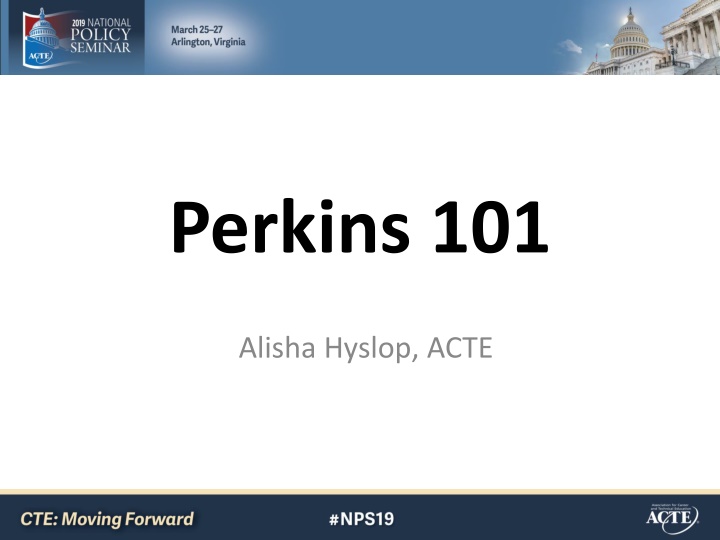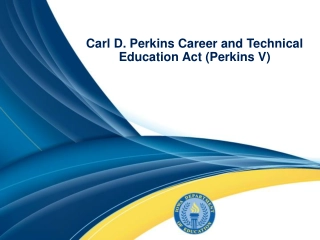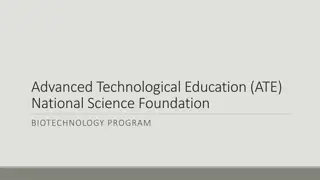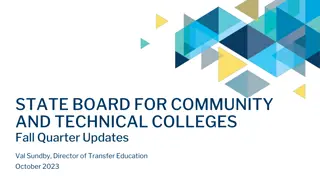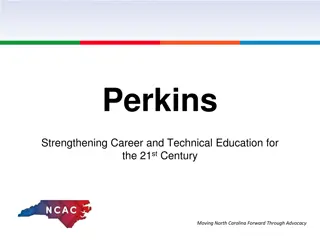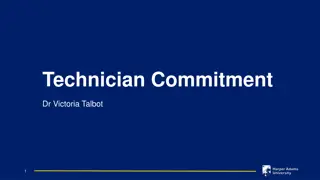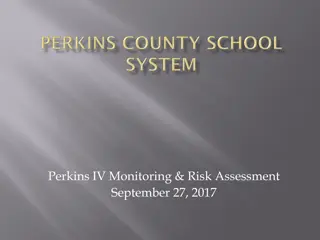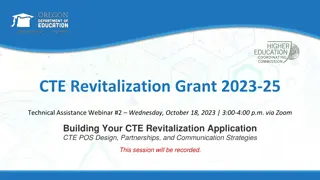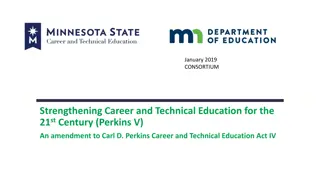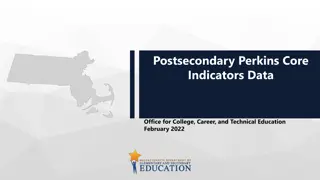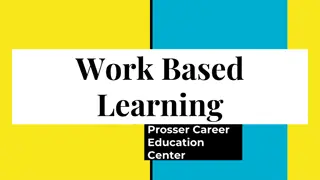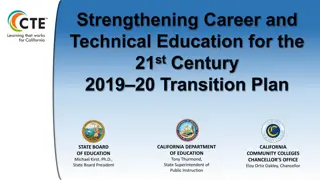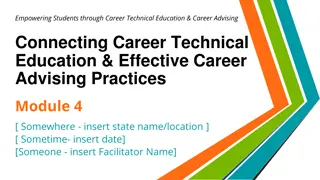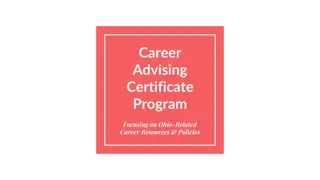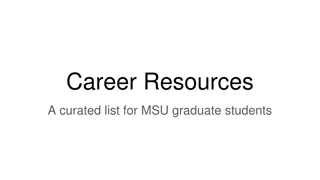Overview of Perkins V: Enhancing Career and Technical Education Programs
Perkins V aims to enhance academic knowledge and technical skills for secondary and postsecondary students in career and technical education programs. It outlines funding streams, definitions, prohibitions, authorization levels, and accountability requirements for states to improve performance levels. Significant changes include increased funding and a focus on data disaggregation and reporting for student success monitoring.
Download Presentation

Please find below an Image/Link to download the presentation.
The content on the website is provided AS IS for your information and personal use only. It may not be sold, licensed, or shared on other websites without obtaining consent from the author.If you encounter any issues during the download, it is possible that the publisher has removed the file from their server.
You are allowed to download the files provided on this website for personal or commercial use, subject to the condition that they are used lawfully. All files are the property of their respective owners.
The content on the website is provided AS IS for your information and personal use only. It may not be sold, licensed, or shared on other websites without obtaining consent from the author.
E N D
Presentation Transcript
Perkins 101 Alisha Hyslop, ACTE
Purpose To develop more fully the academic knowledge and technical and employability skills of secondary education students and postsecondary education students who elect to enroll in career and technical education programs and programs of study
Structure Three funding streams: Title I Basic State Grant Section 114 National Activities Section 117 Tribally Controlled Postsecondary CTE Institutions Title II includes administration provisions Amendments to Wagner-Peyser Act, WIOA and ESSA are included in Title III Effective Date: July 1, 2019
Definitions A total of 55 definitions (28 new to Perkins V) Many linked to WIOA, ESSA and HEA Notable definitions include: Career and technical education Eligible recipients Special populations Program of study
Prohibitions Local control Prohibits requirements around Common Core or other common standards, or the federal government from Requirements for congressional review of regulations
Authorization Levels Bill provides for a 6-year authorization $1,229,568,538 for FY 2019 $1,246,782,498 for FY 2020 $1,264,237,452 for FY 2021 $1,281,936,777 for FY 2022 $1,299,883,892 for FY 2023 $1,318,082,266 for FY 2024 Current funding is $1.263 billion for FY 2019
Accountability States must set performance targets and include in state plan for all four years of plan Secretary still has authority to approve performance levels as part of the state plan review Specific requirements for levels, including that states must continually make meaningful progress toward improving the performance of all career and technical education students including subpopulations Extensive stakeholder review and comment process 60 days before plan submission Adjustments can be made prior to third year and in the case of unanticipated circumstances, but not during improvement plan Data disaggregation and reporting requirements; disaggregation by program of study/cluster as well as race, gender and special population status
Accountability If a state doesn t reach at least 90% of any performance target, they must develop an improvement plan. If they continue to miss the target for 2 additional years, feds can withhold funds Similar state-local process
Accountability All measures are linked to concentrators Definition: A. at the secondary school level, a student served by an eligible recipient who has completed at least 2 courses in a single career and technical education program or program of study; and B. at the postsecondary level, a student enrolled in an eligible recipient who has i. earned at least 12 credits within a career and technical education program or program of study; or ii. completed such a program if the program encompasses fewer than 12 credits or the equivalent in total.
Accountability Secondary indicators: Four-year adjusted cohort graduation (with an option to include extended year rate) for concentrators Proficiency of challenging state academic standards as measured by ESSA assessments (English, math, science) Percentage who, in the second quarter after exiting from secondary education, are in postsecondary education or advanced training, military service, a service program, the Peace Corps, or are employed. Percentage of CTE concentrators in programs that lead to non-traditional fields At least one indicator of program quality: Attainment of recognized postsecondary credentials Attainment of postsecondary credit in the CTE program Participation in work-based learning May include any other measure that is statewide, valid, reliable, and comparable
Accountability Postsecondary indicators: Percentage of CTE concentrators in education, advanced training, the military, a service program, the Peace Corps, or employment during the second quarter after program completion Percentage of CTE concentrators receiving a recognized postsecondary credential Percentage of CTE concentrators in programs that lead to non-traditional fields
National Programs IES Director has a significant role Plan for research, development, dissemination, evaluation and assessment National evaluation (and independent advisory panel) Gathering and reporting of state information Grants, contracts or cooperative agreements for research Innovation and modernization fund grants
State Plan 4-year period; current plan may be extended or a new plan may be submitted after 4 years Combined plan option with WIOA highlighted Significant stakeholder engagement required, including public hearings and a 30-day public comment period Consultation required with other state agencies; Governor consultation and sign-off expanded
State Plan 1. Summary of workforce development activities in the state, and CTE alignment with employer needs 2. The state s strategic vision and goals for preparing an educated and skilled workforce and meeting employer needs, and CTE s role 3. Strategy for any joint planning, alignment, coordination, and leveraging of funds between the state s CTE programs and the state s workforce development system, as well as with other federal programs 4. Description of CTE programs/programs of study that will be supported 5. Criteria and process for how the state will approve eligible recipients for funds
State Plan 6. How the state will support the recruitment and preparation of educators 7. How the state will use state leadership funds 8. How funds will be distributed between secondary/postsecondary 9. Description of the state s program strategies for special populations 10. Procedures state will adopt for determining levels of performance 11. Process for how the state will address disparities or gaps in performance 12. How the state will involves numerous stakeholders 13. Assurances 14. A description of the public comment process
State Leadership - Required 1. Support for preparation for non-traditional fields in current and emerging professions, programs for special populations, and other activities that expose students, including special populations, to high-skill, high-wage, and in-demand occupations 2. Support for individuals in State institutions, such as State correctional institutions, including juvenile justice facilities, and educational institutions that serve individuals with disabilities 3. Support for recruiting, preparing, or retaining CTE teachers, faculty, specialized instructional support personnel, or paraprofessionals, such as preservice, professional development, or leadership development programs 4. Support for technical assistance for eligible recipients 5. Report on the effectiveness of such use of funds in achieving the goals described in the state plan and the state levels of performance, and reducing disparities or performance gaps among subpopulations
State Leadership - Permissive A very long list with 25 items Notable activities include programs of study, articulation agreements, industry partnerships, CTSOs, career guidance and counseling, employability skills, work-based learning, dual enrollment, etc. Ends with other State leadership activities that improve career and technical education
Needs Assessment At the beginning of the law and updated at least once every two years List of groups to consult with regularly Key areas Student performance (including subpopulations) Labor market alignment Size, scope and quality of programs Programs/Programs of study implementation progress Improving educator recruitment, retention and training Strategies for equal access and special populations
Local Consultation 1. representatives of career and technical education programs in a local educational agency or educational service agency, including teachers, career guidance and academic counselors, principals and other school leaders, administrators, and specialized instructional support personnel and paraprofessionals 2. representatives of career and technical education programs at postsecondary educational institutions, including faculty and administrators 3. representatives of the State board or local workforce development boards and a range of local or regional businesses or industries 4. parents and students 5. representatives of special populations 6. representatives of regional or local agencies serving out-of-school youth, homeless children and youth, and at-risk youth (as defined in section 1432 of the Elementary and Secondary Education Act of 1965) 7. representatives of Indian Tribes and Tribal organizations in the State, where applicable 8. any other stakeholders that the eligible agency may require the eligible recipient to consult
Local Application 1. Results of the needs assessment 2. Courses and activities to be supported by Perkins, including at least 1 state-approved program of study 3. Description of career exploration/career guidance and counseling to be provided in collaboration with workforce agencies and other partners 4. Description of academic/CTE integration activities 5. Description of activities for special populations
Local Application 6. 7. Description of work-based learning opportunities Description of how students will be provided an opportunity to gain postsecondary credit while still in high school Description of how the eligible recipient will coordinate with the state and higher ed institutions to support the recruitment, preparation, retention, and training, including professional development, of educators Description of how the eligible recipient will address disparities or gaps in performance among subpopulations (process to be used not actual strategies) 8. 9.
Local Required Uses of Funds Each eligible recipient that receives funds under this part shall use such funds to develop, coordinate, implement, or improve CTE programs to meet the needs identified in the comprehensive needs assessment Funds made available to eligible recipients under this part shall be used to support CTE programs that are of sufficient size, scope, and quality to be effective, and that
Local Required Uses of Funds 1. Provide career exploration and career development activities 2. Provide professional development for educators 3. Provide the skills necessary to pursue high skill, high wage or in-demand occupations or sectors 4. Support the integration of academics into CTE 5. Support implementation of program elements resulting in increased student achievement (20 permissive activities) 6. Evaluation activities
Title II/III Maintenance of Effort Supplement not Supplant Restriction on using funds below 5thgrade GAO Study on Programs of Study aligned to high-skill, high-wage occupations Amendments to Wagner-Peyser
